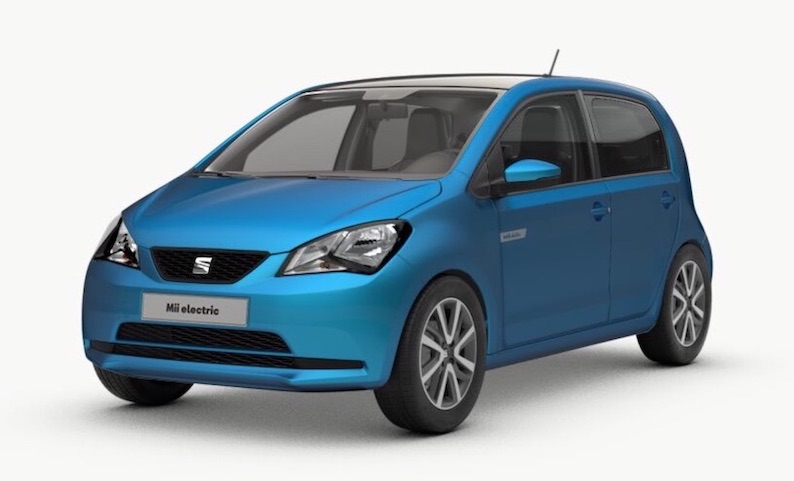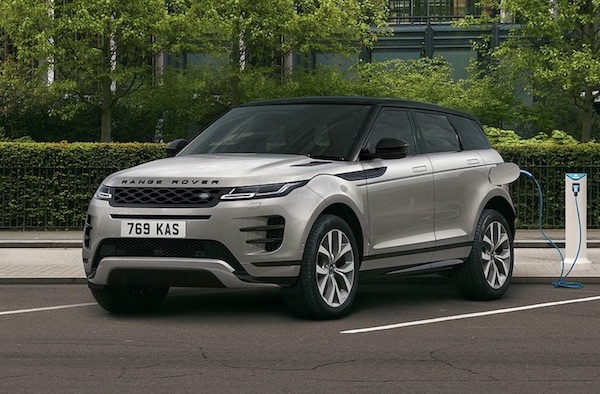Electric Cars: The Basics
For those of you new to zero-emission electric driving, we recommend a read of the following articles:
Sign up to the newsletter
The All-Electric SEAT Mii Hatchback
SEAT S.A. is Spain’s first family car manufacturer. The automotive company was founded in 1950 and is headquartered in Martorell, Spain. In 1986, SEAT was sold to the German automotive group, Volkswagen A.G.
SEAT offers a range of zero-emission electric mobility products, to include, the SEAT MO eScooter, SEAT MO eKickScooter and four-wheel electric vehicles. The company offers battery-electric vehicles (BEVs) and plug-in hybrid electric vehicles (PHEVs). The company’s EV portfolio includes:
- Leon e-HYBRID Hatchback
- Leon e-HYBRID Estate
- Tarraca e-HYBRID SUV
- Mii electric hatchback
The SEAT Mii electric is the first all-electric car from the Spanish automotive company. The pure electric car is targeted at the urban consumer, seeking affordable and clean zero-emission electric driving. The electric vehicle (EV) is suitable for individuals and small families seeking an affordable electric car.
The pure electric Mii has a 36.8 kWh onboard EV battery. It is true, in that, the more recent introduction of electric cars have a larger EV battery, but given the positioning of the Mii Electric, primarily as a city car, the 36.8 kWh battery size is appropriate.
The manufacturer claims a zero-emission electric range up to 258 km (WLTP). Even adjusting for real-world driving conditions, the EV should be able to deliver an electric range over 220 km. A useful and practical EV range for most day-to-day needs and for shorter distance motorway driving.
For those new to electric driving, a number of factors impact the claimed range. These include: driving profile, weather conditions, road surface, wheel size, onboard services used, passenger load and more. The electric car also incorporates regenerative braking to increase the efficiency and electric range.
The SEAT EV offers DC charging up to 40 kW, which is more than sufficient given the size of the onboard EV battery. At 40 kW DC, the EV can be charged up to 80% in 60 minutes. Just enough time for a meal and motorway break. The SEAT Mii Electric incorporates a 7.2 kW AC (1-phase) onboard charger. This again is appropriate, given that most homes in India are powered by single-phase power supply. The EV battery can be fully charged in 4 hours.
We at e-zoomed recommend charging overnight when the electricity tariff prices are cheaper and we also encourage the use of a dedicated home EV charging station like zappi, which is compatible with solar energy. We discourage the use of a domestic 3-PIN plug for charging an electric car.
In terms of performance, the front-wheel drive Mii electric hatchback delivers 0-100 km/h in 12.3 seconds, with a 130 km/h top speed (maximum power: 83 hp/ torque: 212 Nm). The electric car also benefits from instant torque.
The Mii electric car features the SEAT CONNECT, allowing the remote access and management of the vehicle to include, driving data, parking position, vehicle status (incl. doors and lights), e-Manager and remote climatisation.
The Mii BEV also features climatronic, traffic signal reminder, lane assist, bluetooth, USB and smartphone integration and SEAT DriveMii App. In terms of practicality, despite the compact dimensions of the city car, it is comfortable for rear-seat passengers. However the boot size on offer is small (251 L).
Bottom-line, electric driving is good for the environment and the wallet! The SEAT Mii electric hatchback is not available in India.
| PROS | CONS |
|---|---|
| An affordable compact electric car | Electric performance won’t set the heart racing |
| Suitable for cities and towns | Interior can be upgraded |
| Cheap to own and maintain | Limited interior and boot space |
The All-Electric SEAT Mii Hatchback (credit: SEAT)
| At A Glance | |
|---|---|
| EV Type: | Battery-Electric Vehicle (BEV) |
| Vehicle Type: | Hatchback |
| Engine: | Electric |
| Available In India: | No |
| Variants (1 Option) |
|---|
| SEAT Mii Electric (Rs N/A) |
| EV Battery & Emissions | |
|---|---|
| EV Battery Type: | Lithium-ion |
| EV Battery Capacity: | Available in one battery size: 36.8 kWh |
| Charging: | 40 kW DC Rapid Charging (10%-80%: 60 mins). Onboard charger: 7.2 kW AC (10%-80%: 4 hrs) |
| Charge Port: | Type 2 |
| EV Cable Type: | Type 2 |
| Tailpipe Emissions: | 0g (CO2/km) |
| EV Battery Warranty: | 8 years or 160,000 km |
| Charging Times (Overview) | |
|---|---|
| Slow charging AC (3 kW – 3.6 kW): | 6 – 12 hours (dependent on size of EV battery & SOC) |
| Fast charging AC (7 kW – 22 kW): | 3 – 8 hours (dependent on size of EV battery & SoC) |
| Rapid charging AC (43 kW): | 0-80%: 20 mins to 60 mins (dependent on size of EV battery & SoC) |
| Rapid charging DC (50 kW+): | 0-80%: 20 mins to 60 mins (dependent on size of EV battery & SoC) |
| Ultra rapid charging DC (150 kW+): | 0-80% : 20 mins to 40 mins (dependent on size of EV battery & SoC) |
| Tesla Supercharger (120 kW – 250 kW): | 0-80%: up to 25 mins (dependent on size of EV battery & SoC) |
- Note 1: SoC: state of charge
| Dimensions | |
|---|---|
| Height (mm): | 1481 |
| Width (mm): | 1645 |
| Length (mm): | 3556 |
| Wheelbase (mm): | 2420 |
| Turning Circle (m): | 9.8 |
| Boot Space (L): | 251 |
| Mii Electric | |
|---|---|
| EV Battery Capacity: | 36.8 kWh |
| Pure Electric Range (WLTP): | 258 km |
| Electric Energy Consumption (kWh/100km): | 14.9 – 14.4 |
| Charging: | 40 kW DC Rapid Charging (10%-80%: 60 mins). Onboard charger: 7.2 kW AC (10%-80%: 4 hrs) |
| Top Speed: | 130 km/h |
| 0-100 km/h: | 12.3 seconds |
| Drive: | Front-wheel drive (FWD) |
| Electric Motor (kW): | 61 |
| Max Power (hp): | 83 |
| Torque (Nm): | 212 |
| Transmission: | Automatic |
| Seats: | 4 |
| Doors: | 5 |
| Kerb Weight (kg): | 1,235 |
| Colours: | 9 |
| NCAP Safety Rating: | Three-Star |
History Of Electric Cars: Quick Facts
- An electric vehicle (EV), also referred to as a battery-electric vehicle (BEV) is not a new invention or even an invention of modern times. Indeed, EVs were first developed more than a 100 years ago in the 19th century. Put another way, Mahatma Gandhi was yet to be born, when inventors from various countries, to include European countries and the United States were already investing electric motors and batteries.
- The first practical electric cars were built in the second half of the nineteenth century, with the first US electric car introduced in 1890. Mohandas Karamchand Gandhi had just turned 21!
- Electric vehicles came into prominence in the early 1900’s, a time when horse-drawn carriages were the primary mode of transportation. Archived black and white photographs from that period show famous avenues like Madison Avenue in New York city filled with horse-drawn carriages. In stark contrast, a similar photograph taken a decade later of Madison Avenue showed not a single horse-drawn carriage. Instead the avenue was filled with motor vehicles, a new invention. It was the beginning of man’s love affair with cars that has lasted more than a century and still going strong.
- However, the uptake of electric vehicles in the early 20th century was short-lived, as gasoline powered vehicles propelled by internal combustion engines (ICE) become the preferred mode of transportation.
- Bottom-line, manufactures chose internal combustion engines over electric cars in the early 1900s for various reasons, to include, the costs and production volumes.
- It is not definitive as to where EVs were invented or to credit a single inventor. However, one known electric motor (small-scale) was created in 1828 by Anyos Jedlik, a Hungarian inventor, engineer, physicist and Benedictine priest. Hungarians and Slovaks still consider him to be the unsung hero of the electric motor.
- Shortly after, between 1832 and 1839, a Scottish inventor Robert Anderson created a large electric motor to drive a carriage, powered by non-rechargeable primary power cells. Through the 19th century a number of inventors were inspired to develop electric motors to include, Thomas Davenport, an American from Vermont credited with building the first DC electric motor in America (1834). Unlike many of his contemporaries and other trying to build electric motors, Davenport did not have a background in either engineering or physics. In fact, he was a blacksmith.
- Move forward a few decades and at the end of the 19th century, William Morrison created what is believed to be the first practical electric vehicle. Morrison, another American from Des Moines, Iowa, was a chemist who became interested in electricity. He build the first electric vehicle in 1887 in a carriage built by the Des Moines Buggy Co. His first attempt was not a great success. In 1890, he attempted again, with more success. 12 EVs were built using a carriage built by the Shaver Carriage Company.
- The batteries were designed and developed by William Morrison. The vehicle had 24 batteries with an output of 112 amperes at 58 volts that took 10 hours to recharge. Available horsepower just under 4 horsepower. The vehicle could accommodate 6 individuals and had a top speed of 14 mph (22.50 km/h).
- Morrison’s success led to others also developing large-scale practical electric cars. At the turn of the century cities like New York had 60 electric taxis. The first decade witnessed strong popularity for electric vehicles. However the popularity was short-lived as internal combustion engine (ICE) gasoline powered vehicles replaced the early electric vehicles. Henry Ford’s success with the then ubiquitous Ford Model T was the ‘beginning of the end’ for electric vehicles. The Model T was cheaper than the prevailing electric cars (US$ 650 Vs US$ 1,750) and could be manufactured at scale. As they say — the rest is history.
While e-zoomed uses reasonable efforts to provide accurate and up-to-date information, some of the information provided is gathered from third parties and has not been independently verified by e-zoomed. While the information from the third party sources is believed to be reliable, no warranty, express or implied, is made by e-zoomed regarding the accuracy, adequacy, completeness, legality, reliability or usefulness of any information. This disclaimer applies to both isolated and aggregate uses of this information.

































